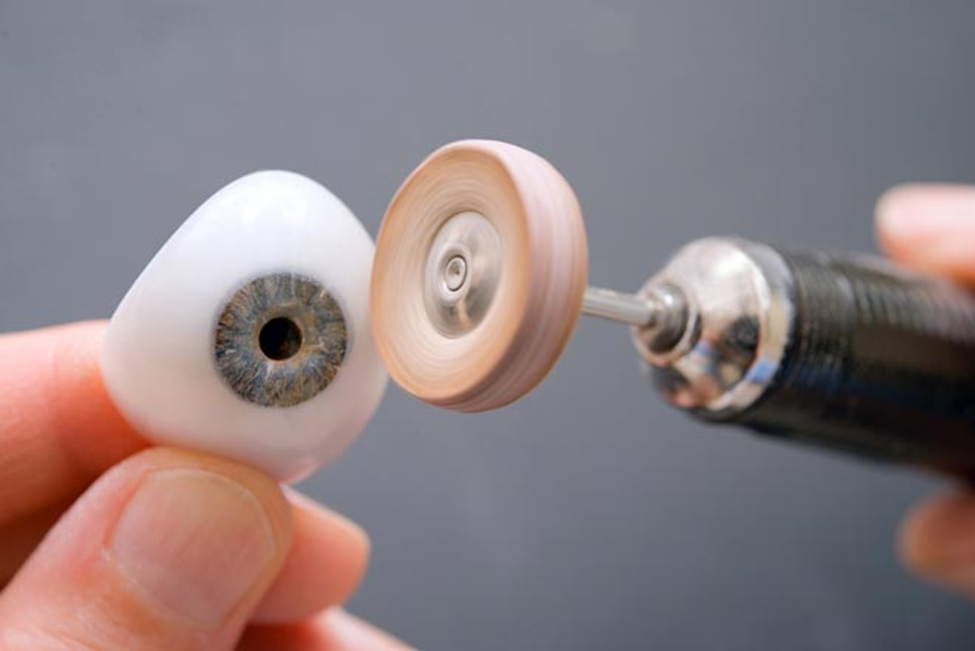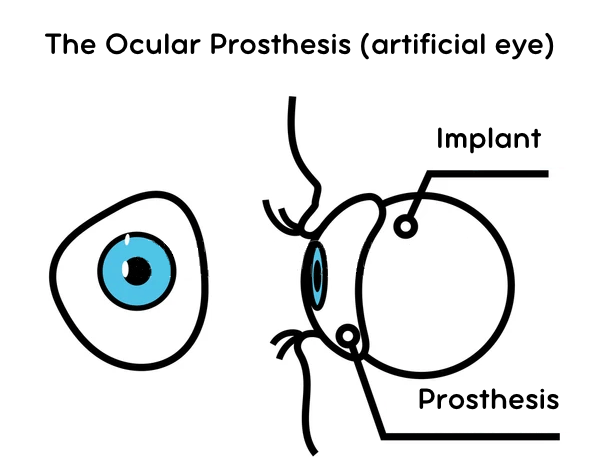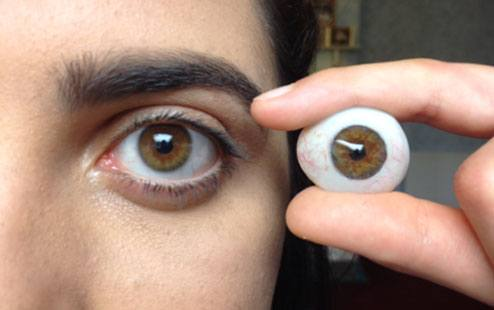PROSTHETIC EYE SURGERY
What is a prosthetic eye?
Prosthetic eyes are a very common treatment option for someone who has lost an eye. People of all ages and genders are fitted for prosthetic eyes after they have an eye (or in some cases, both eyes) removed due to a traumatic eye injury, illness, or eye or facial malformation.
The purpose of a prosthetic eye is to create a balanced facial appearance and increase comfort in the eye socket where the eye is missing.
People have been making and wearing prosthetic eyes for millennia. Early prosthetic eyes were made of clay that was painted and attached to a piece of cloth. Many centuries later, people began making spherical prosthetic eyes from glass. Today, prosthetic eyes are no longer glass spheres. Instead, a prosthetic eye includes a porous round implant that’s inserted into the eye socket and covered with eye tissue called conjunctiva.
A thin, curved, glossy painted acrylic disk made to look like a natural eye — complete with an iris, pupil, white, and even blood vessels — is slipped onto the implant. The disk can be removed, cleaned, and replaced when needed.
If you need a prosthetic eye, you can purchase a “stock” or “ready-made” eye, which is mass-produced and doesn’t have a customized fit or color. Or you can order a “customized” eye made just for you by a prosthetic eye-maker, known as an ocularist. A custom eye will have a better fit and a more natural coloring to match your remaining eye.
When is an Artificial Eye Needed?
An eye prosthesis might substitute the natural eye when the patient complains about pain, having difficulty living with disfigured eyes or is diagnosed with life-threatening conditions relating to the eye. Everyone can be a candidate for a prosthetic eye, regardless of their age, gender, or background. In some cases, scleral shells can be utilized without surgery. But mostly, the nonfunctioning eye should be removed through surgery before fitting the ocular prosthesis. The thought of having one’s eye gouged out could be drastic, but a prosthetic eye can certainly contribute to permanent relief from pain and an easier life with vision loss. The following conditions typically require eye removal surgery before artificial eye fitting.
Blind, painful eye: Ocular diseases might cause intolerable pain in the blind eye. Several treatments can help alleviate the symptoms. According to this study, surgical methods to remove an eye (such as enucleation or evisceration) have proved to be effective in putting an end to the pain.
Trauma: Ocular trauma is an emergency condition and the second cause of blindness after cataract. Some injuries such as ocular bleeding, orbital blowout fracture, or globe rupture are more likely to lead to vision impairment. In severe cases, the ophthalmologist may have to remove the eye entirely in order to replace it with an artificial eye.
Eye cancer: Eye cancer or ocular melanoma should be addressed as fast as possible. If left untreated, this type of cancer may not only damage the vision but also spread to other areas in the body. Although radiation therapy is the most frequently performed treatment, surgery can provide better results in some cases. There are various types of surgical techniques that can be selected based on the characteristics of the tumor and how far it has spread.
End-stage diabetes or glaucoma: Conditions such as diabetes or glaucoma have the potential to result in severe vision loss or blindness. This can also increase the chances of unbearable pain and discomfort in the eye. In such cases, the ophthalmologist might recommend surgery.
If you are having doubts about the advantages and disadvantages of an artificial eye, you can always benefit from an expert’s advice. Contact us now to get a free online consultation from our professional consultants.
How is Artificial Eye Surgery Procedure Performed?
To get artificial eyes, you need to first undergo eye removal surgery. Various techniques can be used during the procedure depending on the patient’s condition and the reason for surgery. Regardless of the method used, eye removal surgery generally involves inserting a porous implant in place of the eye and a transparent shell called a conformer behind the eyelid. A brief description of the main eye removal techniques is as follows:
Evisceration: In this technique, the surgeon removes some of the ocular parts while leaving the sclera (the white section of the eyeball) intact. This is the least invasive method to remove the eye and usually takes much less time. However, not everyone is a candidate for evisceration. The procedure is not recommended for treating severely damaged eyes
or eye cancer.
Enucleation: This method involves removing the entire eyeball including the sclera leaving the rest of the ocular tissue intact. Enucleation is the most common technique of eye removal and can provide satisfactory results for patients with eye cancer. Although the surgery might take more time, there is less pain and swelling following the operation.
Recovery and Aftercare
As mentioned earlier, the surgical procedure to remove the eye can be performed using different techniques. Consequently, the course of recovery can vary depending on each individual’s case and the type of surgery. During your hospital stay, the medical team will monitor your vital signs and improvement. Your eye will be covered with a pressure bandage; you should leave it in place and keep it dry for at least a week.
Within a week, you will have a follow-up appointment with the ophthalmologist. He or she will remove the bandage and make sure everything is okay. After the bandage is removed, it is normal to see some tear discharge that could also include blood.
Typically, patients might feel moderate pain following the surgery. This is, in large part, due to the fact that the muscles and tissues that used to hold the eye are now sore and inflamed. The discomfort can be managed using painkillers prescribed by the doctor.
Upon returning to your home, you should continue following the instructions and guidelines given by your surgeon. Generally, you are told to keep the following tips in mind:
Wash your eyelid gently using a wet cloth to prevent substances from gathering and forming a crust on your eyelid.
Do not rub your eye.
Avoid letting the water run on the operated eye.
Do not engage in strenuous activities especially swimming
Avoid polluted environments
Do not remove the clear conformer until the final prosthesis is ready to replace it
Once you have the artificially eye fitted, you can leave them in until the next ophthalmologist appointment or take them out from time to time. The important thing about taking care of an artificial eye is having the prosthesis polished by an ocularist every year. This will help prevent scratches and maintain the natural appearance of the fake eye. Polishing a prosthetic eye can also prevent infection.
It’s normal to have second thoughts when deciding to undergo any surgery. That’s why our medical experts are at your service for free consultations. Just ask your question and we will get back to you as soon as possible.
How Much Does an Artificial Eye Cost?
Prosthetic eye cost can be anything between $3000 and $8300 in the US. This doesn’t include the cost of eye removal. As with scleral shells, there is no need for eye removal surgery. As a result, they are more affordable options for the appropriate candidates.
In Iran, prosthetic eye surgery costs about $1000 to $2000. In addition to that, Iranian ocularists make the finest artificial eyes, charging almost half the price found elsewhere around the globe.
























